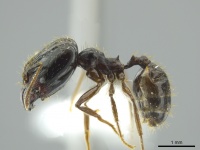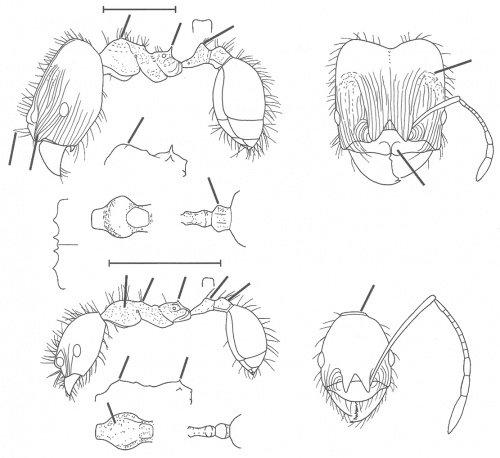Pheidole celaena
| Pheidole celaena | |
|---|---|

| |
| Scientific classification | |
| Kingdom: | Animalia |
| Phylum: | Arthropoda |
| Class: | Insecta |
| Order: | Hymenoptera |
| Family: | Formicidae |
| Subfamily: | Myrmicinae |
| Tribe: | Attini |
| Genus: | Pheidole |
| Species: | P. celaena |
| Binomial name | |
| Pheidole celaena Wilson, 2003 | |
Nothing is known about the biology of celaena.
Identification
See the description in the nomenclature section.
Keys including this Species
Distribution
Known from the type locality in Costa Rica and from Kukra Hill, Nicaragua. (Wilson 2003)
Latitudinal Distribution Pattern
Latitudinal Range: 17.385° to 8.407045°.
| North Temperate |
North Subtropical |
Tropical | South Subtropical |
South Temperate |
- Source: AntMaps
Distribution based on Regional Taxon Lists
Neotropical Region: Costa Rica (type locality), Guatemala, Honduras, Mexico, Nicaragua.
Distribution based on AntMaps
Distribution based on AntWeb specimens
Check data from AntWeb
Countries Occupied
| Number of countries occupied by this species based on AntWiki Regional Taxon Lists. In general, fewer countries occupied indicates a narrower range, while more countries indicates a more widespread species. |

|
Estimated Abundance
| Relative abundance based on number of AntMaps records per species (this species within the purple bar). Fewer records (to the left) indicates a less abundant/encountered species while more records (to the right) indicates more abundant/encountered species. |

|
Biology
Castes
Worker
Minor
Images from AntWeb
    
| |
| Worker. Specimen code casent0624511. Photographer Jeremy Pilllow, uploaded by University of Utah. | Owned by JTLC. |
Major
Images from AntWeb

| |
| Worker (major/soldier). Specimen code casent0624496. Photographer Jeremy Pilllow, uploaded by University of Utah. | Owned by JTLC. |
Nomenclature
The following information is derived from Barry Bolton's Online Catalogue of the Ants of the World.
- celaena. Pheidole celaena Wilson, 2003: 673, figs. (s.w.) COSTA RICA.
Unless otherwise noted the text for the remainder of this section is reported from the publication that includes the original description.
Description
DIAGNOSIS A medium-sized dark member of the tristis group, very close to and possibly synonymous with cornicula, also somewhat similar to Pheidole ambigua, Pheidole amata, Pheidole fera, Pheidole germaini, Pheidole peruviana, Pheidole rogeri, Pheidole rutilana, Pheidole schwarzmaieri, Pheidole superba, and Pheidole vomer, differing as follows.
Major: medium to dark reddish brown; a low angular process protrudes from center of clypeus in side view; mid-dorsal profile of pronotum in side view subangular; petiolar node tapers to a blunt point in side view; postpetiolar node from above roughly trapezoidal; carinulae originating on frontal lobes curve outward to the rear.
Minor: petiolar and postpetiolar nodes very low; humerus in dorsal-oblique view with small denticle; propodeal spines reduced to denticles; nuchal collar present.
MEASUREMENTS (mm) Holotype major: HW l.46, HL l.66, SL 0.80, EL 0.16, PW 0.64. Paratype minor: HW 0.56, HL 0.68, SL 0.82, EL 0.10, PW 0.38.
COLOR Major: head and mesosoma dark reddish brown, waist medium reddish brown, gaster light to medium brown, legs yellowish brown.
Minor: body concolorous plain brown; tarsi yellow; rest of appendages yellowish brown.
Figure. Upper: holotype, major. Lower: paratype, minor. Scale bars = 1 mm.
Type Material
COSTA RlCA: La Selva Biological Station, near Puerto Viejo, Heredia, col. Leeanne E. Tennant-Alonso. Museum of Comparative Zoology
Etymology
Gr celaena, dark, referring to the body color.
References
- Wilson, E. O. 2003. Pheidole in the New World: A dominant, hyperdiverse ant genus. Harvard University Press, Cambridge, MA. (page 673, fig. major, minor described)
References based on Global Ant Biodiversity Informatics
- Fernández, F. and S. Sendoya. 2004. Lista de las hormigas neotropicales. Biota Colombiana Volume 5, Number 1.
- Longino J. T. L., and M. G. Branstetter. 2018. The truncated bell: an enigmatic but pervasive elevational diversity pattern in Middle American ants. Ecography 41: 1-12.
- Longino J. et al. ADMAC project. Accessed on March 24th 2017 at https://sites.google.com/site/admacsite/
- Ottonetti L., L. Tucci, F. Frizzi, G. Chelazzi, and G. Santini. 2010. Changes in ground-foraging ant assemblages along a disturbance gradient in a tropical agricultural landscape. Ethology Ecology & Evolution 22: 7386.


